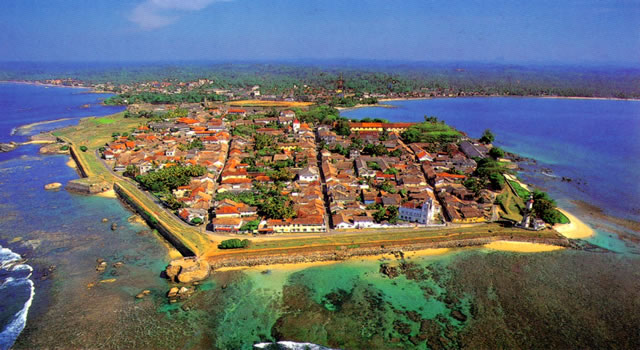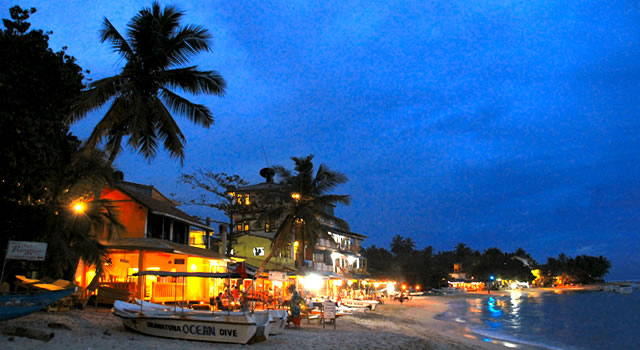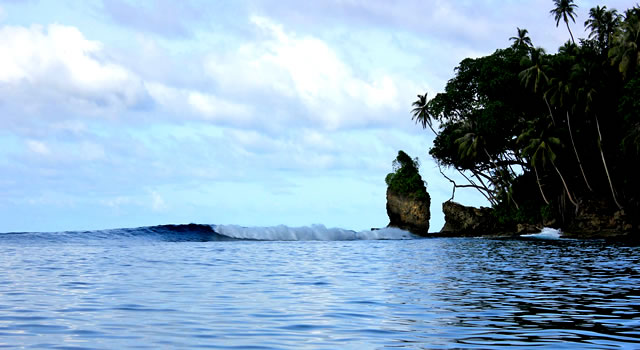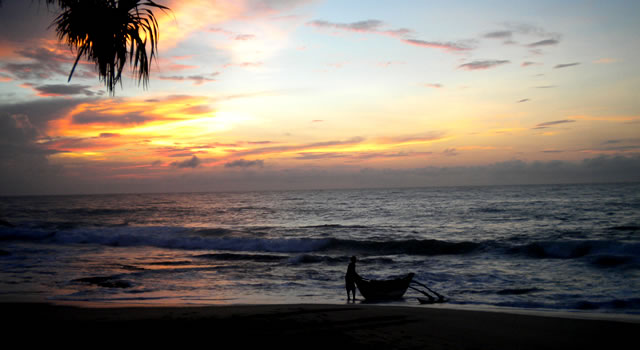The South Coast of Sri Lanka was the first region to offer touristic facilities when the Hippies "discovered" Sri Lanka in the 70's.
Starting initially in Bentota, visitors soon went further south to
put Hikkaduwa and Unwatuna on the travelers map. Today the whole of the
South Coast is fully developed and offers some of Sri Lanka's finest beaches.
The crystal clear water is excellent for swimming, diving and surfing.
Bentota is still the prime beach resort of the South-West Coast but it basically merged over time with the nearby fishing villages of Aluthgama and Beruwela. Nowadays the whole area is a prime destination for
package holidays and all-inclusive tourism.
Having long, beautiful beaches and direct access to a sweet water lagoon Bentota offers the whle range of water based activities including wind surfing, water- jet skiing.
Being one of the most established beach resorts in Sri Lanka, Bentota is known for its professional touristic infrastructure. The many 5* hotels are often build in fantastic locations and even if you don't stay there drop in for a tea and enjoy the scenery.
In the early 1960's Hikkaduwa started its change from a small fishing village into one of Sri Lanka's international holiday destination.
Today backpackers, travelers and package tourist alike favor the beach party atmosphere of Hikkaduwa created by the surfing & diving scene.
Beautiful white sand beaches, colorful coral reefs and an excellent surf are attracting people from all over the world. The surfing in the Hikkaduwa region is quite well known and gets the best surf during its dry season, November to March. There are 4 main breaks. From North to South these are: Locals Break (in front of the A Frame surf shop), Main Peak (in front of Ranjith’s Beach Hut), Hansa Surf Break (just south of Hansa Surf) and Beach Break (south of the Hansa Surf Break).
The port city of Galle is not only of historical interest but the business center for the South of Sri Lanka.
This is the right place if you want to experience the Singhalese culture, away from the touristic hot-spots without loosing out on your holiday itinerary.
Galle was known as Gimhathiththa (although Ibn Batuta in the 14th century refers to it as Qali) before the arrival of the Portuguese in the 16th century, when it was the main port on the island. Galle reached the height of its development in the 18th century, before the arrival of the British, who developed the harbor at Colombo. Galle is the best example of a fortified city built by Europeans in south and southeast Asia, showing the interaction between European architectural styles and south Asian traditions.
The Galle Fort is a world heritage site and the largest remaining fortress in Asia built by European invaders. Other prominent landmarks in Galle include the St. Mary's Cathedral founded by Jesuit priests.
You can spend hours exploring the famous Dutch fort, go shopping at one of the oldest markets of Sri Lanka and the modern shopping complexes or you can enjoy the feeling of "the good old times" at one of the colonial-style hotels and restaurants.
Unawatuna is a beautiful and quiet beach resort just 5 km south of Galle. The name Unawatuna derives its name from the Singhalese words, Onna-wetuna, which translates into "there it fell". Over a period of time, Onna-wetuna became Unawatuna.
The Unawatuna beach is a picturesque semi circular bay, fringed by lush groves of coconut trees. A golden beach which is protected by coral reefs; ideal for safe swimming, snorkeling and scuba diving.
While it started as a "secret" destination for independent travelers and surfers, Mirissa and Weligama are now a popular destination with several boutique hotels, renovated colonial villas and fine restaurants.
While the main focus in Mirissa is the beach, it is a good starting point for excursions, especially to the Yala National Park or the Sinharaja Rain Forest. A short distance to the interior you can find rubber and coconut plantations, ancient temples and spice gardens.
The most enchanting feature of the Weligama Beach is , apart from the unique stilt fishermen, is the small island called Taprobane, located just 200 meters off the shore. Peeping through the lush tropical greenery of the rocky island is red-tiled roof of the exquisite white villa built on the centermost elevation. The villa was built by exiled French Count de Maunay, who owned the island in the 1930s. During the 30 years that Count de Mauny made Taprobane his home playing host to Kings, Statesmen, Aristocrats, Governors and Magnates.
In the "deep south" of Sri Lanka you'll find Tangalle, located between the towns of Matara and Hambantota.
Known for its tranquility, deserted beaches and the unique ECO system,
As Bentota, Hikkaduwa and other famous beach resorts Tangalle has merged with nearby villages including Goyambokka, Pallikkudawa, Medaketiya and Medilla.
Medaketiya in particular has fine white sand, is good for swimming and rarely crowded. 20 km north from Tangalle you'll find the rock temple of Mulkirigala, consisting of natural caves with numerous wall paintings and Buddha statues. One cave houses a library in which, a most important discovery was made in 1826 by a British administrator who found some long-unseen palm-leaf manuscripts containing the key to translating the Mahawamsa, the Great Chronicle of Sri Lanka.







